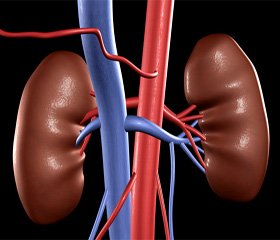Журнал «Здоровье ребенка» 7 (50) 2013
Вернуться к номеру
Congenital Anomalies of Kidneys Quantity: frequency, etiopathogenesis, prenatal diagnostics, clinical picture, physical development, diagnostics, treatment and prophylaxis
Авторы: Nikitina N.A., Starets E.A., Kalashnikova E.A., Galich S.R., Sochinskaya T.V., Sochinsky A.V. - Odessa National Medical University, Department of Propedeutics of Pediatrics, Ukraine
Рубрики: Педиатрия/Неонатология
Версия для печати
anomalies of the kidneys, a doubling of the kidneys, additional kidney.
The doubling of kidneys occurs in about 1 out of 150 newborn, 2 times more often in girls. In the clinic doubling of kidneys is detected in the ratio 1:30, the ratio between right- and left- and two-sided doubling is 4:2:1. The third additional kidney is a rare anomaly.
The doubling of kidneys is a fusion of normal kidney with a small, additional, one in an enlarged kidney. Each kidney has its own circulatory system.
In a doubled kidney there exist zones of “overlapping”of intrarenal vessels. There are 3 types of this anomaly: a doubling of the kidney (complete, partial); doubling the urinary tract without doubling of the kidneys (complete, partial); combination of the kidney doubling and urinary tract.
According to MKB 10 there is Q62.5 Doubling of the ureter (optional, doubled), and the doubling of the kidneys in MKB is absent.
The literature provides information about an autosomal recessive type of inheritance.
The most typical prenatal ultrasonic signs of doubling of the kidneys is the increase of one kidney compared with the other; the presence of the double acoustic signal of cup-and-pelvis complex on one side. On complete doubling of the kidneys, two isolated kidneys with two separate ureters, running into the bladder on their own, are visualized on one side. On partial doubling of the kidneys the common ureter is visualized, ultrasonic picture is similar to that in hypertrophy or kidney dysplasia.
The complete doubling of the kidneys may be accompanied by the malformation of the lower segment of ureters – intestinal, vaginal or urethral ectopia in girls (this case is characterized by a constant flow of urine while the normal urination is preserved, which may be taken for incontinence). A doubling of the kidney is often combined with urethrocele- and vesicoureteral reflux and abnormalities of internal genital organs.
The doubling of the kidneys may be asymptomatic or it may manifest itself in the form of transient microproteinuria and microhematuria. Clinical manifestations of this disease depend on the disease of the abnormal kidney. There may be any acquired renal diseases in the doubled kidney. Quite rarely the doubling of the kidneys is accompanied by arterial hypertension.
A doubling of the urinary tracts may be an accidental finding during the ultrasonic examination and on addition of an acquired renal disease - on urinary x-ray examination, angiographic studies, cystoureteroscopy, radioisotope imaging.
The presence of doubling of the urinary tract does not require treatment. When there are complications of the congenital defect, treatment is carried out according to the general rules, but it’s more long-term and systematic. Nephroureterolithiasis of the doubled kidney require surgical intervention in some cases –heminephrectomy.
The prognosis is favorable, especially in case of a unilateral doubling.
The prophylaxis consists in prevention of teratogenic factors influence in the period from 16 to 70 days, especially on the 3rd week of gestation; identification of the doubling of the kidneys in relatives and conducting the educational discussions about the possible hereditary nature of this defect.
The third additional kidney is an isolated organ, lying separately from the two main kidneys - lower and more medial.
According to MKB-10 it refers to Q63 - other congenital malformations of the kidneys.
Q63.0 Additional kidney.
The genesis of this defect is similar to doubling of the kidney, but the too fast differentiation leads to a complete separation of the two metanephrogenic blastemas with the formation of two kidneys. The additional kidney always has its own fibrous capsule, circulatory system, cup-and-pelvis system and ureter. More often the ureter opens as the third additional mouth into the bladder, the lower and more medial than two main mouths, but it may also merge with the ureter of the main kidney according to the type of the split ureter. Prenatal diagnosis is based on ultrasonic visualization of the additional kidney in the lumbar region, in the pelvis or in the ileum and which has smaller sizes.
It’s usually combined with congenital pathology of the main kidneys.
The additional kidney doesn’t show any clinical manifestations before the appearance of any disease in it. It can be hypoplasive, misplaced, have cysts.
If the surgical intervention is necessary (hypoplasia, dysplasia, persistent inflammatory process) organ-preserving operations on the additional kidney are inappropriate.

